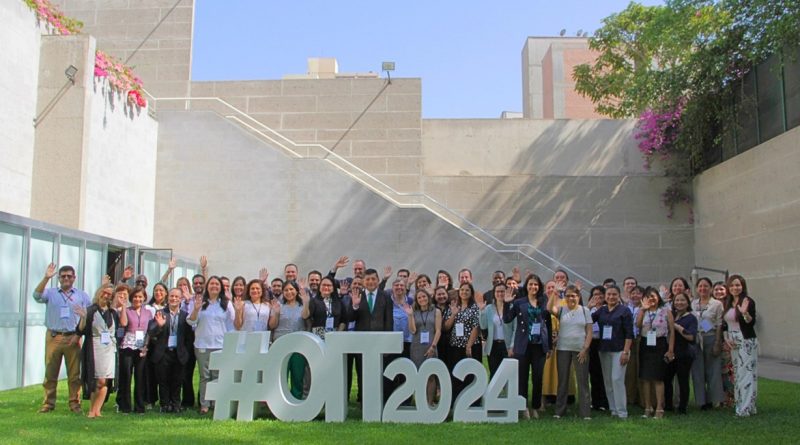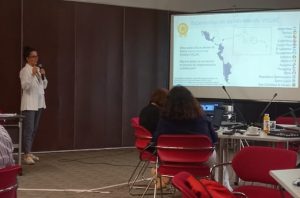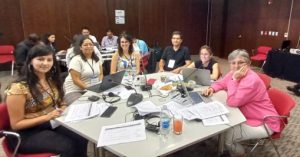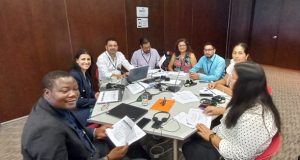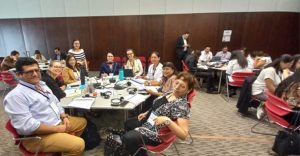Discussing the challenges and methodologies to measure trafficking in persons for the purpose of forced labor
Lima, Peru, 9 February 2024. From 5-8 February 2024, the UNODC-INEGI Center of Excellence participated in the Expert Group Meeting (EGM) on the Development of Questionnaires for Surveys on Trafficking in Persons, along with other 15 National Statistical Offices (NSO) of Latin America and the Caribbean, organized by the International Labor Organization (ILO) in collaboration with Peru’s National Statistical Office (INEI- Instituto Nacional de Estadística e Informática).
Human trafficking often goes unreported due to its hidden and illegal nature and the fears of victims. Several Sustainable Development Goals (SDG) address the issue of trafficking in persons, and SDG indicator 16.2.2 specifically calls the international community to monitor the number of victims of trafficking in persons by forms of exploitation, sex and age, in order to keep track of the progress made to prevent and combat this crime. However, to this date, no standardized methodology is available to estimate the number of victims of trafficking in the world.
This is why the EGM was organized under the STATIP (Standard Tools for Analysing Trafficking in Persons) Project framework, to produce consistent, ethical and robust methodologies to measure the prevalence of trafficking in persons (TiP), forced labour (FL) and trafficking for forced labour (TiP4FL). STATIP has the financial support of the United States of America, and is jointly implemented by the ILO, the United Nations Office on Drugs and Crime (UNODC), the International Organization for Migration (IOM), and the University of Georgia (UGA) since 2023.
During the EGM, a first draft of a questionnaire to measure prevalence of trafficking in persons for the purpose of forced labor and forced labor was presented for the review of delegates from 15 NSO from countries in Latin America and the Caribbean.
It was also discussed that National Statistical Systems may need to use all statistical projects to provide a comprehensive and complementary overview of the phenomenon and household surveys provide an option to provide statistics together with the administrative records from the judiciary and migration institutions. Household surveys look to address the estimation of the prevalence and extent of human trafficking within a population, providing a clearer understanding of the scope and magnitude of the issue. However, these types of surveys need to address several statistical challenges such as the definition of victim, sampling design, ethical considerations during data collection, lack of awareness of this phenomenon, the complexity of data validation and the cross-border dynamics of the crime.
UNODC Research and Analysis Branch (RAB) mentioned the importance of measuring prevalence and another summarizing the recommendations and challenges arising from the analysis of the legal definitions of trafficking in persons and forced labor produced by UNODC within the framework of the STATIP project.
The UNODC-INEGI Center of Excellence delivered a presentation on the lessons learned by UNODC regarding the implementation of Crime Victimization Surveys in Latin America and the Caribbean through the LACSI Initiative, mentioning its construction process (2013-2015), as well as the main challenges and lessons learned with 15+ countries that have adopted the initiative since 2015. Examples of methodological decisions and discussions regarding conceptual and implementing challenges were presented, to guide the discussions on measuring TiP for forced labor.
It should be noted that UNODC and IOM developed and published in 2023 the International Classification Standard of Administrative Data on Trafficking in Persons (ICS-TIP), a methodological tool fully in line with the UNODC International Classification of Crimes for Statistical Purposes (ICCS), designed to integrate data collected by different reporting entities at international, national and sub-national level. It allows data to be referenced on different levels of analysis (victims, perpetrators, crime, reporting entities) collected through different sources in a single database, and it’s applicable worldwide regardless of the existing level of data collection capacity. ICS-TIP sets standards for data governance on TiP.
In the framework of the STATIP Project, methodological guidelines and tools are currently being produced and will be presented for review by NSO in different worlds regions throughout 2024. The tools will be also tested through pilot surveys to be conducted in 2024 and 2025. The international standards produced and tested within the framework of this project will be presented to the UN Statistical Commission in 2026.
For more information about STATIP Project, you can contact the UNODC-INEGI CoE (unodc-mexico.cde.estadistica@un.org) or Ms. Giulia Serio, Research Officer, UNODC (giulia.serio@un.org).



